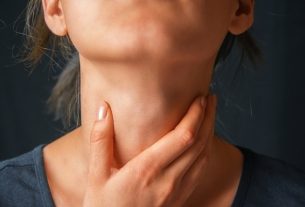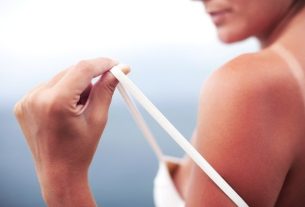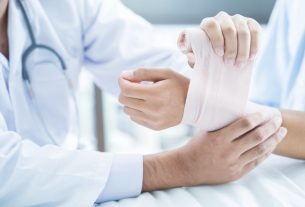For most burns, the most important step is to quickly cool the skin so that the deeper layers do not continue to burn and cause injury. In addition, ointments can be used, according to medical advice, to relieve pain and aid the healing process.
However, depending on the degree of the burn, care may be different, especially for third-degree burns, which must be evaluated as quickly as possible by a doctor, in the hospital, to avoid serious complications such as destruction of nerves or muscles.
In all cases of burns, it is not recommended to apply coffee powder or toothpaste, for example, to the burn, as this can cause even more irritation, increase the risk of infection and hinder the healing process.
What to do for 1st degree burn
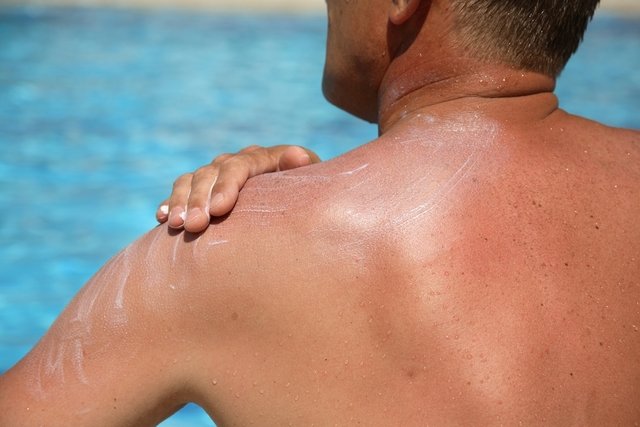
First-degree burns only affect the superficial layer of the skin, causing signs such as pain and redness in the region. In these cases it is recommended:
- Place the burned area under cold water for at least 15 minutes;
- Keep a clean cloth dampened in cold water in the region for the first 24 hours, changing whenever the water heats up;
- Do not apply any product, as oil or butter, on a burn;
- Apply a moisturizing or healing ointment for burns, such as Nebacetin or Ointment. See a more complete list of ointments;
This type of burn is more common when you stay in the sun for a long time or when you touch a very hot object. The pain usually disappears after 2 or 3 days, but the burn can take up to 2 weeks to heal, even with the use of ointments. Generally, a 1st degree burn does not leave any type of scar on the skin and rarely presents complications.
What to do for a 2nd degree burn
Sensitive content
This image may contain content that is uncomfortable for some people.
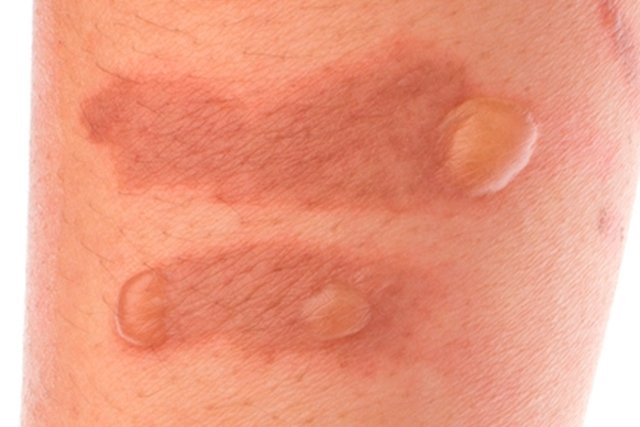
A 2nd degree burn affects the intermediate layers of the skin and, therefore, in addition to redness and pain, other symptoms such as blisters or swelling of the area may appear. In this type of burn, it is recommended:
- Place the affected area under cold running water for at least 15 minutes;
- Carefully wash the burn with cold water and neutral pH soap, avoiding scrubbing too hard;
- Cover the area with wet gauze or with plenty of Vaseline, and secure with a bandage, during the first 48 hours, changing whenever necessary;
- Do not pierce the blisters and do not apply any product to the area, to avoid the risk of infection;
- Seek medical help if the bubble is too big.
This burn is more common when the heat is in contact with the skin for a longer period of time, as happens when hot water is spilled on clothes or when holding something hot for a long time, for example.
In most cases, the pain improves within 3 days, but the burn may take up to 3 weeks to disappear. Although 2nd degree burns rarely leave scars, the skin may become lighter at the site.
What to do for 3rd degree burns
Sensitive content
This image may contain content that is uncomfortable for some people.
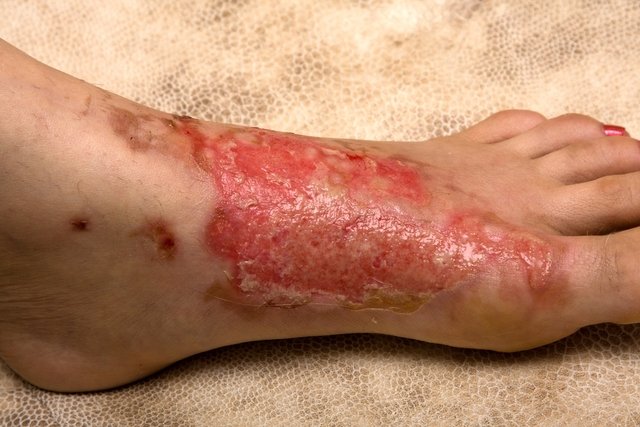
A 3rd degree burn is a serious situation that can be life-threatening, as the deeper layers of the skin are being affected, including the nerves, blood vessels and muscle. Therefore, in this case it is recommended:
- Call an ambulance immediatelycalling 192 or take the person quickly to the hospital;
- Cool the burned area with saline solutionor failing that, tap water, for about 10 minutes;
- Carefully place a moistened sterile gauze in saline solution or a clean cloth on the affected area until medical help arrives. If the burned area is very large, you can wrap a clean sheet moistened with saline solution that does not shed hair;
- Do not place any type of product in the affected region.
In some cases, a third-degree burn can be so severe that it causes multiple organ failure. In these cases, if the victim faints and stops breathing, cardiac massage should begin.
Since all layers of skin are affected, nerves, glands, muscles and even internal organs can suffer serious damage. In this type of burn, you may not feel pain due to the destruction of the nerves, but immediate medical help is needed to avoid serious complications, as well as infections. Know how to recognize a 3rd degree burn.
Read too: 14 treatments for 3rd degree burn
When to go to the hospital
Most burns can be treated at home, however, it is advisable to go to the hospital when the burn is larger than the palm of your hand, has many blisters or is a third-degree burn, which affects the deeper layers of the skin. Furthermore, if the burn also occurs in sensitive areas such as hands, feet, genitals or face, you should also go to the hospital.
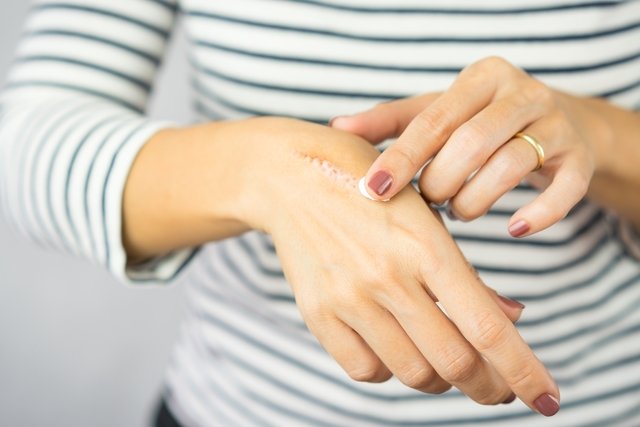
Main questions
Below are the main questions about what to do in case of a burn:
1. Does applying toothpaste or coffee grounds improve the burn?
Toothpaste, coffee grounds, butter, egg whites, chopped onions or vinegar have no effect on the scar and can even delay the healing process and increase the chances of bacterial infection. Therefore, the best way to treat a burn is to place the burned area under cold water until the skin cools down.
Afterwards, ointments suitable for burns with soothing, healing and antibacterial properties can be applied. See some examples of burn ointments.
2. Can I burst the bubble?
The bubble is the body’s way of protecting the affected region against infections, so it should not be popped. If it does burst, you should wash the area well with water and neutral soap.
Furthermore, if the skin is stuck together or sticks together after the ball is popped, it should not be disturbed. The skin can only be removed in the hospital by a trained professional, as it can cause other damage to the skin.
3. Can I remove the tissue that is stuck to the burn?
If clothing or an object is stuck to the burn, it is not recommended to remove it, as this can cause greater injury, increase the risk of infection and delay healing. In these cases, it is important to go to the nearest hospital or emergency room so that the tissue or object can be removed safely.
4. Does putting ice on the scar relieve symptoms?
Despite being cold, ice should not be used, as excessive cold can harm the skin and cause new burns and injuries. In addition to ice, it is important to avoid using cotton wool over the burned area, as it can stick to the skin and interfere with the healing process.
5. What can relieve burn pain?
Burn pain can be relieved with just cold water on the burned area. However, there are homemade ointments that can alleviate burn symptoms and aid healing. Find out which homemade ointment is used for burns.
6. Does aloe vera gel help with the burn healing process?
Aloe vera is a medicinal plant that has anesthetic, anti-inflammatory, healing and moisturizing properties, so it can be used to help with the scar healing process, as long as there is no wound in the area.
7. Does a cold milk compress help with healing?
Cold milk compresses can be used to treat sunburn, as they reduce burning and swelling of the skin, as well as hydrating it. See other burn remedies.

Sign up for our newsletter and stay up to date with exclusive news
that can transform your routine!
Warning: Undefined array key "title" in /home/storelat/public_html/wp-content/plugins/link-whisper-premium/templates/frontend/related-posts.php on line 12
Warning: Undefined array key "title_tag" in /home/storelat/public_html/wp-content/plugins/link-whisper-premium/templates/frontend/related-posts.php on line 13

